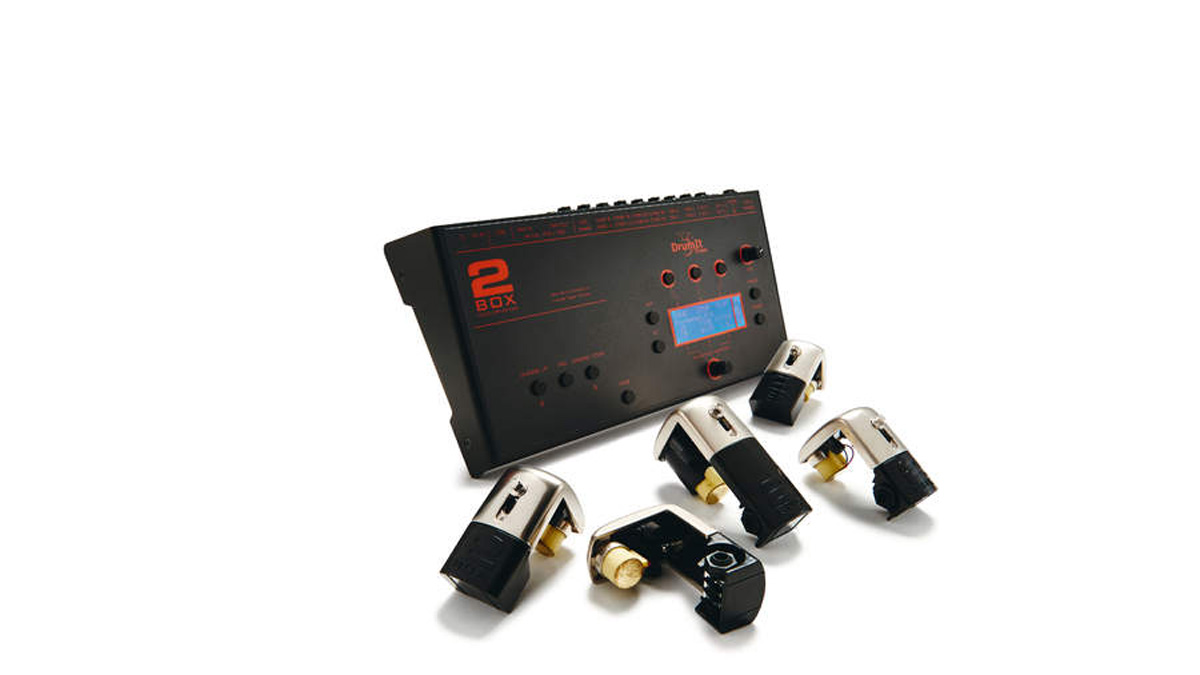MusicRadar Verdict
Despite a slightly complicated user interface, the Drumit Three module is a seriously powerful machine, which comes in at an affordable price.
Pros
- +
Good price.
Cons
- -
Tricky interface.
MusicRadar's got your back
Following on some years later from the Drumit Five e-kit, 2Box’s Drumit Three module has just hit the market with a host of new features up its sleeve.
Boasting ‘Open Sound Architecture’ and a ‘Universal Trigger Interface’, the DI3 promises to make a worthy replacement for your existing e-kit module or a powerful hub at the centre of your hybrid setup.
Build
In terms of appearance, the Drumit Three is a no-frills affair. The angular body is black for the most part with text and other highlights appearing in the trademark 2Box orange. There is a small LCD display on the right of the module with a rotary controller underneath and other additional buttons correlating to menu items on the screen.
Navigation works through a page up and down system under two main ‘kit’ and ‘unit’ menus. From the main kit menu we scroll through 100 kit slots of which there are a massive 90 pre-programmed kits. Impressively, these include signature kits from drumming giants such as Marco Minnemann, Simon Phillips and Randy Black.
In terms of connectivity, we find the usual phones output and a line-in (both ¼" stereo jack), four mono jack outputs (programmable as master outputs, bus sends or sub outputs) and 14 trigger inputs, which include A and B cymbal triggers to accommodate three-zone cymbal pads. The module can handle kick, snare (three-zone), four tom pads (dual-zone), hi-hats and three cymbals.
The sheer amount of customisation possible means that the DI3 comes into its own as a hybrid tool
The Universal Trigger Interface supports many types of piezo and switch triggers ranging from 2Box’s own hardware to Roland, Yamaha, Alesis and more. With an inbuilt 4GB memory and no external expansion available, surprisingly, the module is already at over 90 per cent capacity straight out of the box. However, due to the open source nature of the system, it is possible to back up the original sounds via the computer and start afresh, should you wish to free up space.
Using the 2Box Drumit Editor software it is possible not only to tweak the existing kits but also create multi-layered user sounds completely from scratch. This is a huge feature, especially at this relatively low price point. Included with our review module is a set of five 2Box Trigit acoustic triggers - one larger model specifically for bass drum and four smaller snare/tom (dual-zone) versions. The satin chrome drum triggers have a sleek appearance and fit snugly to the kit via drum key bolts.
Hands on
After initially wiring in the module with our Roland e-kit, we excitedly dive into exploring the kit presets, only to find that some work is required in order to set up our pads correctly. Where modules like the ATV aD5 have setup wizards with a list of kit or pad models to choose from, the DI3 requires the trigger type to be selected for each individual pad. Following this, there is still some additional tweaking to be done before it starts to feel completely natural.
With the admin out of the way, we get down to the business of checking out the inbuilt kits. Overall, the samples are of a high quality, although in isolation some are a little noisy (we even find a ride sample where we hear what sounds like a rickety cymbal stand). The kits play very naturally and have great dynamic response, particularly in the snare and ride cymbals.
Ghost notes move seamlessly into accented notes and rimshots while ride patterns are translated well, even with our basic dual-zone pad. The toms have a natural quality to them and are far from over-produced, although some are tuned rather high and sometimes don’t feel quite right for the respective kits.
With the help of the drag-and-drop Drumit Editor software, we manage to put together a couple of kits using our own samples, which brings playability to the next level. The sheer amount of customisation possible means that the DI3 comes into its own as a hybrid tool. Pads can be programmed to play backing tracks and loops, control the metronome (start/stop or tap tempo) and advance through kit patches. In addition, there are mute group capabilities and the vast routing options allow you to choose an output destination for each individual element. Imported tracks can even send the left and right channels individually for split click and track.
Using the 2Box Trigit triggers, we are able to experiment with bringing this functionality to the acoustic kit and it makes for hours of fun. Using only minimal triggers to layer up the kick and snare also offers pleasing results in terms of dynamic response and works wonders in beefing out the sound of our acoustic kit. General navigation of the module takes some getting used to and it’s definitely one where you’ll want to keep the manual close at hand.
Tom is a professional drummer with a long history of performing live anywhere from local venues to 200,000 capacity festivals. Tom is a private drum tutor, in addition to teaching at the BIMM Institute in Birmingham. He is also a regular feature writer and reviewer for MusicRadar, with a particular passion for all things electronic and hybrid drumming.











